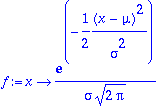
Harj. 12 AV
5.12.2001 HA
1.
> restart:
Warning, the name changecoords has been redefined
> f:=x->mu^x/x!*exp(-mu);

> 1-sum(f(x),x=0..1);subs(mu=1/2,%);evalf(%);
![]()

![]()
2.
> restart:
Warning, the name changecoords has been redefined
> f:=x->mu^x/x!*exp(-mu);

> P_alle_5:=sum(f(x),x=0..4);subs(mu=5,%);evalf(%);
![]()
![]()
![]()
Nämä olisivat sopineet olemaan a)- ja b)-kohta samasta tehtävästä, mutta olkoon kompensaationa menneistä työläisyyksistä.
3.
Pohdiskellaan hieman Poissonin jakaumaa tässä yhteydessä KRE exe 3:n s. 1082 hengessä.
Siinä otetaan esimerkisi parkkipaikka, johon tulee keskimäärin 2 autoa minuutissa. Kysytään, millä todennäköisyydellä satunnaisesti valitun minuutin aikana saapuu x autoa
(tai jokin vastaava kysmys, johon jakaumafunktion avulla voidaan vastata).
Yleisemmin voidaan ottaa 2:n auton sijaan
![]()
autoa.
Jaetaan 1 min aikaväli pieniin osiin, n kpl. Todennäköisyys, että näistä keskimäärin
![]() :sta sisään tulevasta autosta jokin osuu tietylle osavälille :
:sta sisään tulevasta autosta jokin osuu tietylle osavälille :

Tilannetta voidaan ajatella toistokokeena, jossa näitä pieniä aikavälejä vedetään aikasäkistä.
Näin saadaan
> f:=x->B(n,x)*p^x*(1-p)^(n-x); # B on binomikerroin
![]()
Kun n kasvaa, niin jakauma lähenee Poissonia (
![]() ).
).
Sitten varsinaiseen tehtävään: Otetaan tämä exa 3 lähtökohdaksi.
> restart: with(combinat): alias(B=binomial):
Warning, the name changecoords has been redefined
Warning, the protected name Chi has been redefined and unprotected
>
fB:=x->B(n,x)*p^x*(1-p)^(n-x);
fP:=x->mu^x/x!*exp(-mu);
>
![]()

> mu:=2: p:=mu/n;
![]()
> n:=10:plot([fB(x),fP(x)],x=0..n,color=[blue,pink]);
![[Maple Plot]](images/harj12av17.gif)
> sum(fB(x),x=0..5);evalf(%);sum(fP(x),x=0..5);evalf(%);
![]()
![]()
![]()
![]()
> n:=20:plot([fB(x),fP(x)],x=0..n,color=[blue,red]);sum(fB(x),x=0..5);evalf(%);sum(fP(x),x=0..5);evalf(%);
![[Maple Plot]](images/harj12av22.gif)
![]()
![]()
![]()
![]()
> n:=30:plot([fB(x),fP(x)],x=0..n,color=[blue,black]);
![[Maple Plot]](images/harj12av27.gif)
> n:=60:plot(fB(x)-fP(x),x=0..10);
![[Maple Plot]](images/harj12av28.gif)
4.
> restart:
Warning, the name changecoords has been redefined
> with(inttrans):alias(u=Heaviside): # alias(u=inttrans[Heaviside]):
a)
> Int(a+b*t,t=30..90): %=value(%);

> rhs(%)=1,a+90*b=0;
![]()
> solve({%},{a,b});
![]()
> f:=unapply((u(t-30)-u(t-90))*subs(%,a+b*t),t);
![]()
> plot(f,20..100);
![[Maple Plot]](images/harj12av33.gif)
> Int(f(t),t=-infinity..infinity): %=value(%); # Tarkistus.

> F:=int(f(x),x=-infinity..t);F:=collect(%,{u(t-30),u(t-90)});
![]()
![]()
> plot(F,t=20..100,axes=box);
![[Maple Plot]](images/harj12av37.gif)
> convert(F,piecewise);
![PIECEWISE([0, t <= 30],[-1/3600*t^2+1/20*t-5/4, t <...](images/harj12av38.gif)
b)
> FF:=unapply(F,t);
![]()
> FF(60)-FF(40);evalf(%);
![]()
![]()
> 1-FF(60);
![]()
c)
> mu:=int(t*f(t),t=30..90);
![]()
> int((t-mu)^2*f(t),t=30..90);sqrt(%);evalf(%);
![]()
![]()
![]()
5.
> restart: with(combinat): alias(B=binomial):
Warning, the name changecoords has been redefined
Warning, the protected name Chi has been redefined and unprotected
> f:=x->B(M,x)*B(N-M,n-x)/B(N,n);
![]()
> N:=20: M:=5: n:=3:
> f(x);f(0),f(1),f(2),f(3);evalf(%);
![]()
![]()
![]()
> plot(f,0..3);plot([seq([x,f(x)],x=[$0..3])],style=point,symbol=cross,symbolsize=20,axes=box);
![[Maple Plot]](images/harj12av51.gif)
![[Maple Plot]](images/harj12av52.gif)
> with(plots):with(plottools):display([seq(line([x,0],[x,f(x)]),x=[$0..3])],color=blue,axes=box,linestyle=6,thickness=2);
![[Maple Plot]](images/harj12av53.gif)
>
6.
> restart:
Warning, the name changecoords has been redefined
> with(plots):
> F:=x->Phi((x-mu)/sigma);
![]()
> toda:=1-F(x1);
![]()
> mu:=12000: sigma:=2000: x1:=15000: toda;
![]()
> Phi:=x->1/2+1/2*erf(x/sqrt(2));
![]()
> toda;evalf(%);
![]()
![]()
> f:=x->1/(sigma*sqrt(2*Pi))*exp(-1/2*((x-mu)/sigma)^2);

> display(plot(f,mu-3*sigma..x1),plot(f,x1..mu+3*sigma,filled=true,color=red));
![[Maple Plot]](images/harj12av61.gif)
b)
> 1-F(x)=0.02;
![]()
> plot(lhs(%)-rhs(%),x=mu+sigma..mu+3*sigma);
![[Maple Plot]](images/harj12av63.gif)
> x2:=fsolve(1-F(x)=0.02,x=16000);plot(f,x1..x2);
![]()
![[Maple Plot]](images/harj12av65.gif)
>
>